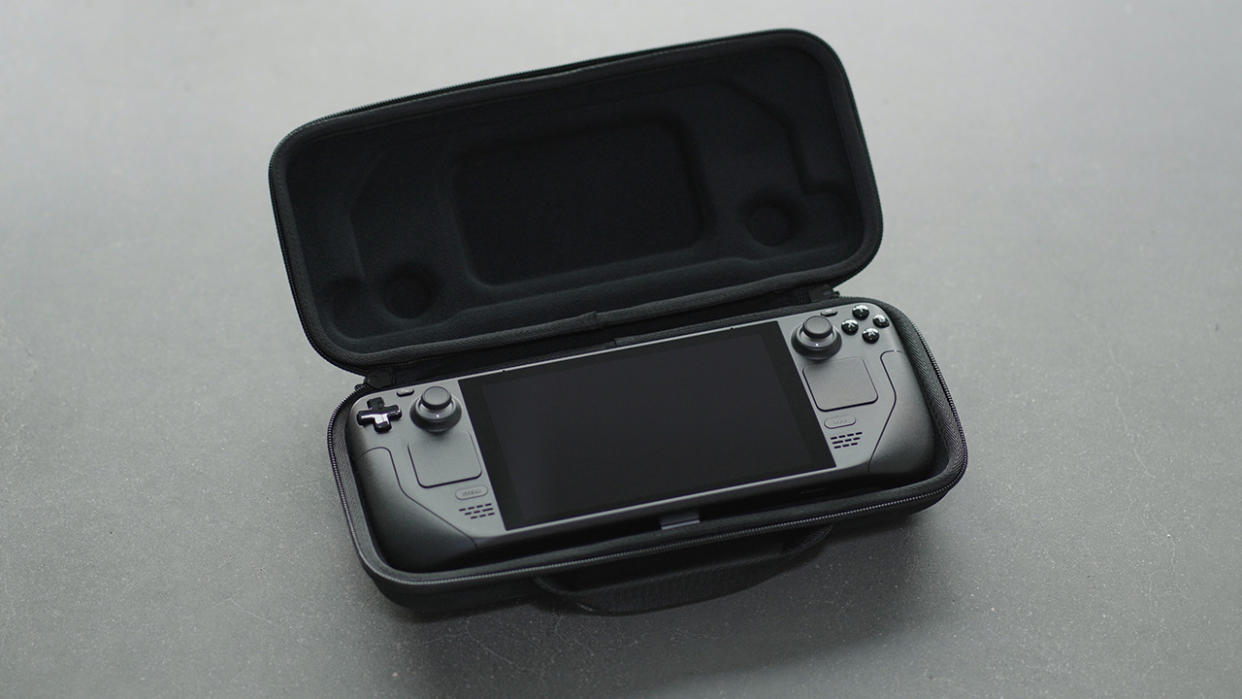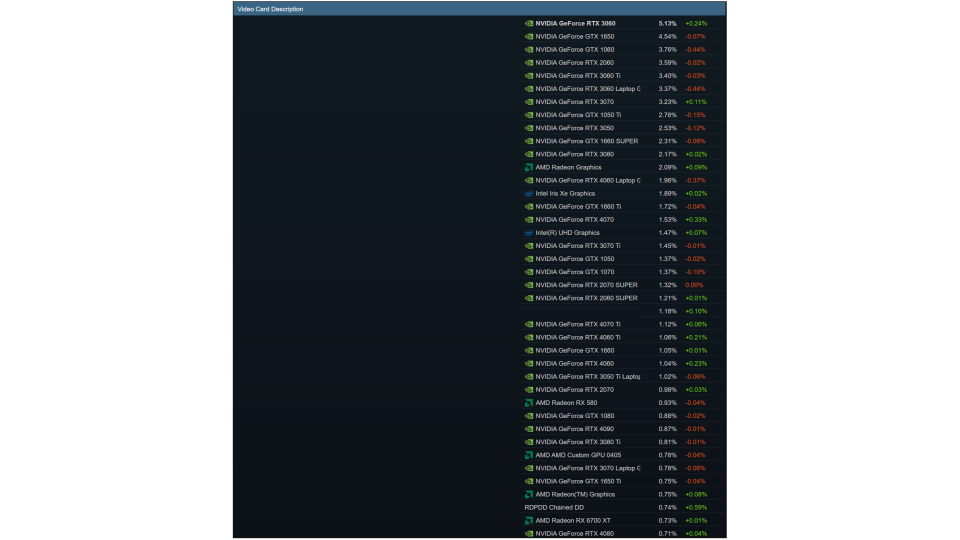Steam survey suggests more people bought the RTX 4090 than the Steam Deck — along with millions of other RTX 40-series GPUs

Valve has released its Steam Hardware Survey for December, the last of 2023, and the figures are about the same as what they were in November's survey. However, we've taken a closer look at the numbers and there are some interesting points where the data doesn't make a ton of sense. Par for the course, but let's dig a bit deeper.
GPU market share numbers and weird statistics
In the overall results for DX12 GPUs, AMD and Intel showed slight gains while Nvidia lost a small amount of market share. Summing everything up, Nvidia dropped by 0.5% while AMD and Intel went up about a quarter of a percent each. This put AMD at about 15%, Intel at 5%, and Nvidia at 80%, which isn't far off Jon Peddie Research estimates.
The Vulkan and DX11 tables show potentially even larger swings, though some of that might be due to the sheer number of different GPUs shown in the Vulkan table. Note also that we "corrected" the provided data to normalize all columns to 100% total — for reasons known only to Valve, the Vulkan table sums up to around 196~197 percent, while the DX12 and DX11 tables sum to 90~96 percent, depending on the month.
Nvidia's 10-, 16-, 20-, and 30-series GPUs continue to sit at the top of the charts, though the RTX 40-series parts now roughly match the 10- and 16-series for overall popularity. AMD's most popular GPUs remain non-specific integrated graphics, the old RX 580, and the RX 6700 XT, and the RX 7900 XTX continues to be the sole representative listed on the survey statistics. Hmmm. Intel's Arc Alchemist cards aren't even on the board, and the company's most popular GPU is Iris Xe integrated graphics.
What's particularly interesting about AMD's numbers is that they only add up to around 6% if we look at the past three generations, well below the 15% total market share that AMD occupies above. This seeming hole in AMD's numbers is explained by integrated graphics, which Valve only reports as generic integrated graphics in various ways. Roughly a third of AMD's GPUs in the survey (5% total share) are some form of integrated graphics — which also matches the 5% of the market that goes to varying models of Intel integrated graphics.
Things get even more fun when we look at Valve's Steam Deck numbers, which uses an AMD APU powered by RDNA 2 integrated graphics. The Steam Deck's integrated graphics market share is actually quite high on the survey at 0.78%, just below the RTX 4090 at 0.89% — you'll need to click to expand the "Video Card Description" on the main survey page to see the Steam Deck, which shows up as "AMD AMD Custom GPU 0405." The implication here is that there are almost as many Steam Decks around as there are RTX 4090s.

Except, when you think about that more, something doesn't feel quite right. Valve hasn't disclosed sales figures for the Steam Deck, but projections from firms like Omdia peg the total sales by the end of 2023 to hit roughly three million. If that's the case, then not only would there be over three million 4090s out there, but also about 7.5 million RTX 4060 Laptop cards and nearly 20 million RTX 3060 desktop cards, with a total of roughly 384 million monthly users on Steam.
Those numbers don't make a ton of sense. For starters, Statista estimates Steam had 132 million monthly users in 2021 and we doubt it increased that much. It's also hard to imagine a single desktop graphics card that costs over $1,600 outselling a critically acclaimed PC that starts at $400. The Steam Deck has certainly sold well, but the percentages Valve lists seem to skew quite high on the various desktop GPUs by comparison.
Perhaps we should just chop all those figures in half (i.e. 1.5 million Steam Decks would be 0.78% of the total). Even so, that would scale to indicate around 17.5 million RTX 40-series owners in total, 50 million RTX 30-series users, 16.5 million RTX 20-series gamers, and 21 million each for the GTX 16- and 10-series families. Those are certainly possible figures, but in contrast the survey would indicate only around 600,000 RX 7000-series users — all of them with an RX 7900 XTX, mind you, as the remaining cards would fall into the unclassified 'other' category that accounts for around 20 million GPUs. AMD would also have 6.3 million total RX 6000-series owners, with a similar 6.7 million combined for the RX 5000- and 500-series parts.
As we've seen many times in the past, there's not enough context here to fully dissect Valve's data, and the Steam Hardware Survey continues to be rather opaque. These surveys are also error-prone, as we've seen in the past with situations like PCs at internet cafes being counted multiple times, and the data from August through October as another example appeared to skew more heavily toward Nvidia for a few months. Stuff like this happens at least a couple of times a year, so at best all we can do is raise an eyebrow and point out the discrepancies.
CPU market share numbers — Apple silicon gradually kicks out Intel, and Intel claws back Linux share
Unlike the GPU section, the CPU section doesn't give us any specific processors. Instead, things are categorized by vendor, clock speed, and core count, and those last two aren't particularly useful. Plus, market share is divided by operating system, meaning it's unclear how the overall picture looks.
There were no major changes between AMD and Intel on Windows, and even compared to January of last year the numbers haven't really changed. That's not unexpected as 2023 was a very slow year for x86 CPUs, especially for Intel, which only launched its 14th Generation Raptor Lake refresh CPUs in October and Meteor Lake CPUs in December.
Apple started the year at 52.31% market share to Intel's 47.66% in MacOS, and now Apple has crossed the 70% mark. It's been just over three years since the M1 chip launched, and Apple has clearly won over its customers with its custom silicon.
Throughout the year, AMD has made strong gains in Linux, going from 55.45% share in January 2023 to 69.03% in the latest December survey. Although Intel is very much down, the company has actually increased its share slightly since August. It's pretty easy to guess how AMD surged so much in market share, though: it's the Steam Deck.
Operating system share numbers — The Steam Deck rules Linux, Windows 7 is dead
The operating system section also has some interesting tidbits, especially when it comes to Linux and Windows. Windows is still by far the most popular OS family at 96.4% market share, with MacOS and Linux languishing with less than 2% each. But Steam support for Windows 7/8 has ended, for the less than 1% of Steam users that were still hanging around.
It's hard to get a feel for exactly how popular the Steam Deck is, but one thing is clear: it's by far the most popular Linux PC for gaming. As of the December survey, roughly 40% of Steam users running Linux were doing it on the Steam Deck, which is impressively close to a majority. However, the Deck is actually down 2.46% since November, meaning it's probably reached its limit for the time being — that or there was another twitch in the sampling methodology.
If you crunch the numbers and assume the Deck does indeed represent 40% of Linux users, which make up 1.97% of Steam users, then the Deck is used by 0.78% of all Steam users. That's the exact market share number for the Deck APU in the GPU survey, which means at least these datapoints are internally consistent.
It's pretty clear why Windows 7 and 8.1 are no longer supported on Steam as of yesterday: They don't even make up 1% of Windows users. As for Windows 10 and 11, the two OSes are basically in a stalemate, with the older operating system holding the upper hand. However, this isn't entirely unusual, and Windows 7 lasted for a very long time before being discontinued in 2020. Windows 10 is slated to get the axe in 2025, so by then Windows 11 might overtake it.

